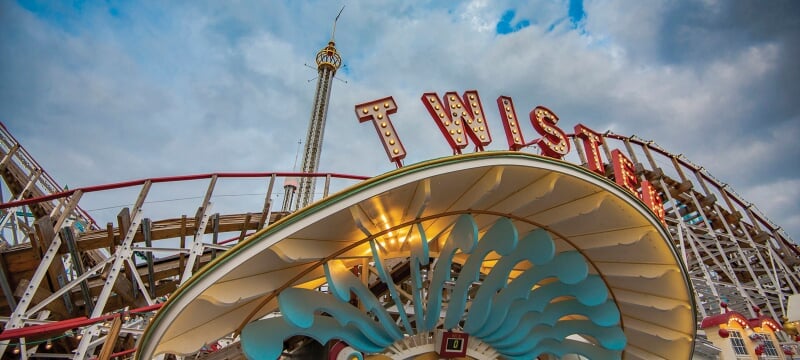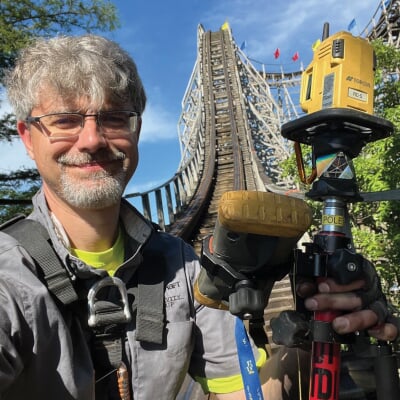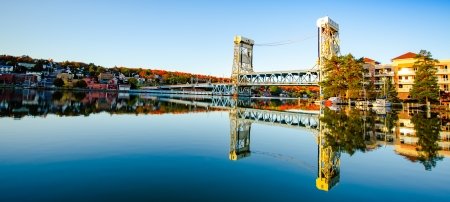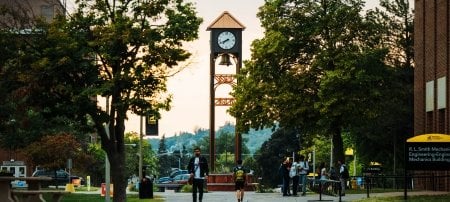Korey Kiepert ’97 ’99, co-founder and mechanical engineer at The Gravity Group, is pushing the boundaries of wooden roller coaster design with innovative techniques that are helping to transform the industry.
Korey Kiepert knew early in life that he was “predisposed towards mechanical things.” He grew up riding roller coasters at Cedar Point Amusement Park in Sandusky, Ohio, and was inspired by the engineering influence of both his grandfathers—one a shipbuilder and the other a Chrysler employee in the Detroit area. After attending a genetic engineering course as part of Michigan Tech’s Summer Youth Programs, he decided he wanted to study engineering at a school with small class sizes and more personalized learning opportunities. He soon found his way back to Tech, where he earned a bachelor’s and a master’s degree in mechanical engineering.
At Tech, Kiepert learned the engineering and design concepts he knew were needed to be successful in the wooden roller coaster industry. In 2002, a few years after graduating, he co-founded The Gravity Group LLC. Kiepert and his team have since designed 29 wooden roller coasters: five in Europe, 11 in the United States, one in Australia, and 12 in China.
After graduation, how did you break through into the wooden roller coaster industry?
KK: After graduating from Tech, I started working in Cincinnati as an engineer at Custom Coasters, a wooden roller coaster company that made 34 roller coasters. In 2002, that business ended up closing, but the four of us on the engineering team liked what we were doing. So we decided to give it a go and formed The Gravity Group. We were without jobs and enjoyed working as a team on rides, so we wanted to give it a try.
What’s your process when starting to design a wooden roller coaster?
KK: We design many of the rides we work on specifically for their one unique location. For example, the ride Twister is right on the edge of the water at a park in Stockholm, Sweden, named Gröna Lund. The ride essentially goes over, under, and through a bunch of other roller coasters and rides in the park. When the park approached us, they asked, “Can you even fit a ride here?” We said yes—then we had to figure out how to make it work. Now, it looks like the ride belongs there.
I think the best thing for me when visiting a park is to talk to the management team. I try to understand what their goals are for the ride. Sometimes the park wants something that’s very thrilling. Other times, they want something that’s more family focused. You have to understand what the client wants. At The Gravity Group, we like to take a location and a project and say, “Wow, what can I do to make this extra fun?”
What is the most rewarding roller coaster you’ve helped design?
KK: A little ride called the Wooden Warrior at Quassy Amusement Park in Middlebury, Connecticut, was pretty special. It’s only 32 feet tall but still delivers a fun ride experience. That was the original family coaster that our company did. It ushered in an era of “small but mighty” rides we have since designed.
But, you know, anything you work on is fun. I don’t have a favorite ride or project that I’ve worked on. It’s like children; I have four kids, and they’re all very different. I mean, they’re similar, but they have such different personalities, such different dreams. In many ways, it’s like that when we design a ride. They’re all different, they’re all fun, and I have good memories of all of them.
How is The Gravity Group helping to advance the wooden roller coaster industry?
KK: I did some work with epoxy and the fatigue of composites for my master’s research, and we’re now using a proprietary epoxy in our newly patented wooden track system. Instead of doing a layered track lying flat, we like to turn the track on its side. It’s just a small change, but it’s so much stronger that way. The area moment of inertia is so much larger for wood on its end rather than flatwise. So we actually take wood and cut the shape of the track in it, then press it together with an epoxy, giving parks a perfectly shaped track that is substantially stronger than a traditional wooden coaster track.
We also modernized the way that we make our trains. A lot of the classic wooden roller coaster cars were typically designed like boxes with wheels: as they go around a turn, they bounce back and forth, creating a sort of stop sign shape, because they can’t steer through curves. They’re like matchbox cars; all four wheels just go straight. We made a wheel system that pivots and has a tie-rod system. If you look at your automobile, the front wheels turn because there’s a steering system between them that ties everything together. So we created a steerable wheel system on our Timberliner cars that can follow the track. Instead of bouncing and stop-signing, we’re able to smoothly follow the curve.
We’re also cutting track and structure in a more precise way using CNC (computer numerical control) machines in our shop. It used to be that wooden roller coasters were made with two or three drawings. There was a lot of field modification. Now, we know where every bolt, every fastener should be on the structure and can make sure we’re meeting the code edge distances and end distances. There are a lot more calculations, drawings, and documentations that go into modern wooden roller coasters than the rides of yesteryear.
Are there other jobs engineers could consider in the theme park industry?
KK: There’s a whole world of engineering and design in the industry, and also in all the other work that goes into the parks. For instance, electrical engineers work on the control systems for our rides. They need to understand how to safely keep one train from getting too close to another train. When people think of engineers and theme parks, I think a lot of people focus just on the design of the rides, but there’s a lot more to it than that. Geotech engineers might take soil borings to help civil engineers with the design of foundations for rides. Civil and structural engineers might design different buildings for restaurants and shops in the parks. Other engineers design special effects like lighting on rides.
What advice would you give an engineering student interested in designing wooden roller coasters?
KK: Make sure that you love engineering, first and foremost. Engineering was a good fit for me and my personality; the Michigan Tech engineer humor came naturally. I enjoyed calculus. I even liked differential equations. When you look at a wooden roller coaster structure, you can kind of see the matrix methods all fit together. At Tech, I tried to plot out classes I thought would be useful if I were to design rides. I took Dynamics and Advanced Dynamics. I sought out the Structural Steel Design classes. Timber Design was also really beneficial for me.
I remember a conversation in the MEEM elevator when I was in school. A professor was talking to someone and he said, “You know, as an engineer, you could basically give something a try until you’re 45, and even if you went to a big corporation and started over at that age, you’d still do fine and have enough money to retire.” Something like that was going through my mind at the time we formed The Gravity Group. We could give it a try and just see what would happen. If it didn’t work out, there were always other companies that I could go to. I would give that same advice to engineering students today: Try something you’re interested in and give it a few years. It might work out, it might not. Either way, you’ll still have the skills you need to succeed.
Michigan Technological University is an R1 public research university founded in 1885 in Houghton, and is home to nearly 7,500 students from more than 60 countries around the world. Consistently ranked among the best universities in the country for return on investment, Michigan's flagship technological university offers more than 120 undergraduate and graduate degree programs in science and technology, engineering, computing, forestry, business, health professions, humanities, mathematics, social sciences, and the arts. The rural campus is situated just miles from Lake Superior in Michigan's Upper Peninsula, offering year-round opportunities for outdoor adventure.





